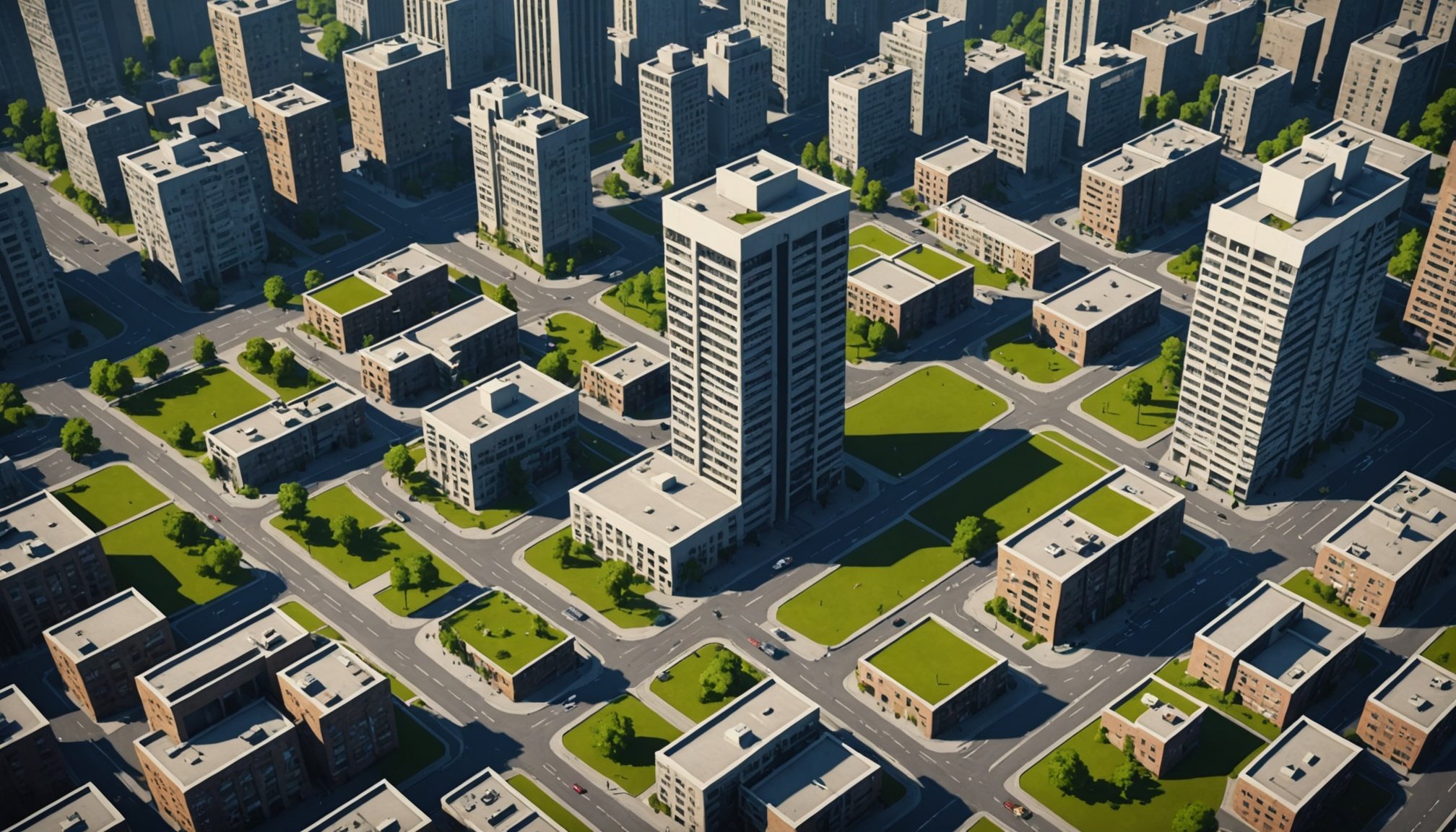Understanding Procedural Generation in City-Building Games
Procedural generation is a gaming technique where content is algorithmically created rather than manually designed. This approach uses algorithms to produce diverse urban landscapes, offering endless possibilities in city-building games. Originally birthed from the need for efficient content creation in gaming’s formative years, procedural generation has evolved to become a crucial element in creating vast, dynamic environments.
Historical Context
Procedural generation stretches back to early digital entertainment, where it addressed hardware constraints by generating vast worlds with limited resources. It provides a rich framework for exploration, crucial for city-building games seeking to create varied urban designs without the impracticality of conventional methods.
Also read : Revolutionizing RPGs: Harnessing Machine Learning for Stunning Facial Animation Innovations
Relevance to City-Building Games
In these games, procedural generation reshapes urban planning dynamics. Instead of predetermined layouts, players explore constantly changing cityscapes, enhancing strategies and creativity. The unpredictable nature of these environments offers both challenges and opportunities for players, elevating the genre’s appeal.
Combining elements of randomness and structure, procedural generation fosters unique, personalized urban experiences. Players must navigate shifting landscapes, making strategic decisions that directly impact the in-game cities they build, offering a truly immersive experience in urban design.
Also to discover : Transforming Rhythm Gaming: Experience AI-Powered Adaptive Music Scores for Unforgettable Soundtracks
Impact on Urban Design and Gameplay Experiences
Procedural generation significantly influences urban design within city-building games by introducing dynamic and engaging gameplay mechanics. Unlike static, pre-designed environments, this method allows for endless variations in city layouts, which encourages players to think creatively and adapt their strategies in real-time. As players navigate complex urban transformations, their gameplay experience is enriched by feeling like architects of ever-evolving worlds.
The impact on player agency is profound. By offering unpredictable urban landscapes, procedural generation empowers players to make autonomous decisions. They must adapt their strategies to the cities’ unique growth patterns, fostering an atmosphere of exploration and decision-making. Crucially, this freedom enhances the immersive quality of city-building games, as players directly influence the transformation and success of their urban environments.
Several game titles demonstrate how procedural generation can produce unique experiences. In “Cities: Skylines”, players face the challenge of managing a sprawling metropolis, whereas “SimCity” leverages dynamic systems for personalising urban experiences. Meanwhile, “Planet Coaster” showcases intricate design possibilities, engaging players through creative task-based goals. Each case illustrates how procedural generation can expand gameplay potential, catering to a wide array of player preferences in urban design.
Case Studies of Popular Titles
Exploring procedural generation through popular titles showcases its dynamic influence on city-building games. Each title uniquely implements algorithms to enrich urban design and player experiences.
Cities: Skylines
In “Cities: Skylines,” procedural generation masters urban scale realism. Players manage traffic, zoning, and infrastructure within a sprawling metropolis, where each decision resonates through the simulated city. Advanced algorithms create diverse neighborhoods, demanding strategic urban management. Players praise the flexibility and depth allowed by procedural tools, fostering an engaging community.
SimCity
“SimCity” stands as a beacon of dynamic systems. Procedural generation governs city growth and environmental conditions, providing players autonomy over ever-evolving urban environments. Its focus on resource management and unpredictability encourages players to foresee and adapt to challenges. This game exemplifies how procedural techniques personalize urban experiences, drawing thoughtful engagement from its audience.
Planet Coaster
With “Planet Coaster,” procedural generation supports intricate, task-based goals, inviting creative urban design within theme parks. Here, the focus is on meticulous design possibilities, where players construct personalized experiences. The community lauds its creative freedom, driven by procedural algorithms, which inspires imaginative park configurations.
Through these titles, procedural techniques in city-building games reveal their potential, appealing to diverse player strategies and experiences.
Technical Insights on Design Methods
Diving into the technical aspects of design methods in gaming reveals the complexity and ingenuity behind procedural techniques. At the core are sophisticated algorithms that generate diverse urban environments, providing variety and depth in city-building games. These algorithms vary in complexity, from simple random number generators to advanced fractal-based systems, each enabling unique cityscapes and enhancing gameplay.
Implementing these procedural techniques involves overcoming significant technical challenges. One common issue is ensuring algorithmic coherence—maintaining logical and aesthetically pleasing urban landscapes while allowing for randomness. Developers address this by using constraint-based methods, which help create structured yet varied environments.
Another challenge is balancing emergent gameplay with player control. Adaptive algorithms that respond to player actions ensure environments evolve dynamically without sacrificing user agency. Data-driven design and machine learning also provide solutions, enabling more intelligent procedural generation.
Innovations continue to shape urban game design. Hybrid methods combining hand-crafted elements with procedural generation offer greater control and creativity. The development of more sophisticated algorithms and enhanced computational power promises even more complex, lifelike cities, pushing the boundaries of what’s possible in the genre.
Advantages for Urban Environments
Incorporating procedural generation into city-building games enhances the creation of diverse urban environments. This technique crafts unique cityscapes, fostering a sense of discovery and challenge. As players engage with these varied landscapes, they encounter a dynamic setup that continually offers new exploratory opportunities.
The adaptability of generated urban environments also contributes significantly to sustainability and resource management within gameplay. Procedural generation can simulate real-world processes like environmental changes and resource availability, prompting players to develop strategic approaches for sustainable city management. This engagement mirrors real-life urban planning challenges, providing educational value alongside entertainment.
Furthermore, the adaptability of cities generated via procedural techniques ensures that players experience varied urban settings with each gameplay session. The evolving cityscapes maintain player interest by avoiding repetition, which inspires different strategies and gameplay styles. Through this, city-building games provide an environment where players can experiment and innovate on urban design strategies, adjusting to the game’s ongoing transformations.
Ultimately, procedural generation offers compelling advantages for both the design and functionality of urban environments in games, supporting a gameplay experience rich in diversity, sustainability, and adaptability.
Future Trends in City-Building Games
City-building games are poised for exciting transformations with procedural innovation leading the charge. Future trends suggest a shift towards more sophisticated algorithms, enabling increasingly detailed and lifelike urban environments. Emerging technologies such as machine learning and artificial intelligence will play critical roles, allowing games to adapt to player behaviour in real-time, creating a more personalised gaming experience.
One exciting future trend is the incorporation of virtual reality (VR) and augmented reality (AR) to enhance player immersion. These technologies promise to transform the way players interact with their urban constructions, bringing a new dimension to city-building games.
Community-driven development will also potentially reshape the genre. As game developers increasingly engage player communities in the design process, player feedback will directly influence procedural innovations in games. This participatory approach ensures game development aligns with player expectations and encourages creativity, leading to richer gameplay mechanics.
Moreover, sustainability concerns will drive procedural generation to replicate more complex, environmentally-conscious urban planning models. As procedural innovation continues to evolve, city-building games will undoubtedly offer richer, more diversified gameplay experiences, aligning closely with real-world urban challenges and player preferences.











